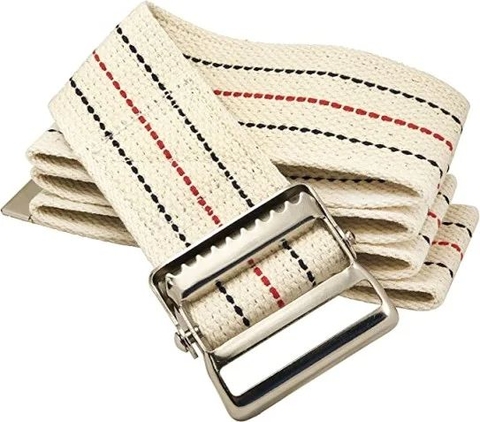
Elderly and weak people are more prone to fall and getting seriously injured. To prevent this from happening, nurses use gait belts. It is a preventive device that keeps the patient safe when standing from a sitting position or walking.
Most of the gait belts have a plastic clip and metal buckle. Others are wipeable that can be used by other patients, too, after proper disinfection. Gait belts made up of durable canvas are intended for single-patient use.
Also used by caregivers and physical therapists, a gait belt is a great option for protecting the patient and themselves.
What are Gait Belts?
A gait belt is a safety device used by the patient to sit, stand, walk, or transfer from bed to wheelchair or vice versa.
Usually, the gait belt is 1.5 to 4 inches wide and 54 to 60 inches long. Several kinds of gait belts are available so the healthcare professional will determine the use of a gait belt.
This works efficiently. A nurse ties the belt around the waist of the patient and grabs the other hand for support when moving together. The belt takes off some of the patient's weight from the nurse or caregiver. It also saves them from too much strain or constant back pain.
Types of Gait Belt
A padded gait belt is an advanced gait belt with pads for comfort and handles for a stronger grip. The purpose is the same as other types of gait belts but provides extra comfort to the wearer.
- Nylon Gait Belt
This belt is used mostly for patient transferring and ambulating. It is suggested to get the nylon belt of more width as it will provide increased contact area with the patient. It is good for higher support and stability of both patient and caregiver.
This belt comes with handles on different edges of the belt for safe patient transfer.
- Bariatric Gait Belt
These belts have extra-long handles to easily and safely transfer obese patients. It also has wipeable plastic straps with welded edges.
There is no fabric joint in this kind of belt. It ensures lower chances of bacterial growth and enhances safety in terms of health.
- Leg Strap Gait Belt
A gait belt with a leg strap loop provides additional support to the patient and helps avoid falls and accidents.
This also offers additional support to the caregiver with more stability and pressure support while transferring a patient. Easy release and removable buckles also make sure a smooth and safe transition.
- Quick Release Gait Belt
This type of belt is different in terms of design. It has a quick-release buckle that assists in easy as well as quick transfer of the patient. Made up of nylon, this belt is strong and washable.
With just a push on the buckle, the caregiver can lock or unlock the belt.
The leg strap gait belt also makes sure that the belt does not ride up and makes a patient worried and uncomfortable.
Using and Applying the Gait Belt
There are many gait practices suggested by Occupational Safety and Health Administration. But one thing is common among all methods the belt should be snug but not overly tight. Keeping at least two fingers gap between the patient and the belt is imperative.
Also, make sure there is at least one layer of cloth between the belt and the patient to avoid any chance of chafing. Before transferring the patient from the bed, remove all the obstacles, such as the bed railing or other objects on the floor. It is crucial to let the patient know about the gait belt. The nurse can count so that both patient and nurse can rise in sync.
Stand behind or beside the patient when walking with the gait belt. The grip should be underhanded with the palm towards the nurse or caregiver. Support the patient and set the same pace as of patient.
A gait belt is a great tool to retain mobility with safety.
When to Use a Gait Belt?
Using a gait belt is not for everyone. As it's an assistive device, the nurse should use it for patients partially dependent on mobility. The device should not be used to lift the patient upright. If the patient cannot move alone, a portable powered or mounted lift device is appropriate for transfer.
Patients with abdominal surgery or a lower back injury need more care while using the gait belt. It is also important to be careful while handling the pats with feeding tubes or other apparatus attached to the abdomen. Consult a doctor to confirm whether using a gait belt is a good option.
If a Patient Falls
Even with the use of a gait belt, a patient may fall. It might be due to dizziness or sudden weakness that leads to a fall.
But it can prevent any possible injury by efficiently handling the patient. A nurse can slow the descent on the floor by supporting the patient using the thigh. It is crucial to let the patient sit on the floor carefully. Also, remember that a patient might try to grab you reflexively while falling, so be prepared and do not lose balance.
Who Shouldn't Use a Gait Belt?
Patients with chest trauma or rib fracture that separates the skeletal wall from ribs cannot use a gait belt. Its use will cause extreme and unbearable pain the patient cannot tolerate.
Moreover, patients who are undergoing the condition of alcohol withdrawal cannot use a gait belt. The patient can use the gait belt as a weapon and become a danger to others. Depression causes emotional traumas that a person to have suicidal thoughts. Nurses should not use gait belts for such patients as they might use them to harm themselves.